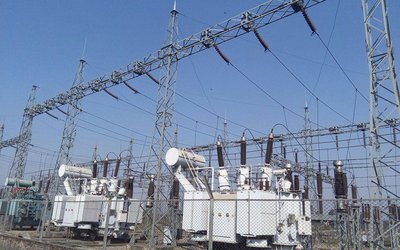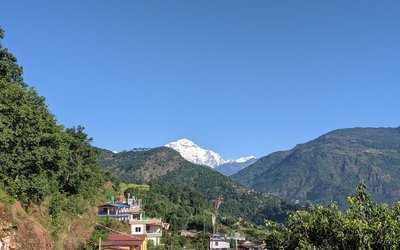Nepal’s twin development challenges are lifting the majority of people from abject conditions of absolute poverty and ensuring secure and peaceful life with inclusive development. The overall goal is to expedite the process that reduces poverty and provides successive generations of citizens not just the basic means of livelihood, but also the broadest opportunities in the social, economic, political, cultural and ecological aspects of their life. Hence the pursuit will be to increase the per capita income, afforded by stable population size, that generates a viable and environmentally sound domestic resource base and creates and nurtures the institutions of the state and markets and civil society, whose services can be equitably accessed and shared by all Nepali people belonging to different walks of life.
Nepal’s Development Status
Nepal has succeeded in accelerating the pace of poverty reduction. With economic growth slowing to 3-3.5 percent in the year 2013 and inflation remaining high at 9.5 percent, Nepal’s development sector performance, however, is not going very well. Although there are strong inflows of remittance, the external current account is likely to post a small deficit. Financial sector problems constitute a major economic risk, with signs of liquidity stress in the economy. Experts have already suggested the need to carry out structuring of bank assets.
The average annual economic growth at constant prices during the last three years was just 4.0 percent, with 3.6 percent in agriculture and 4.2 percent in non-agriculture. Due to favorable climate conditions, the agriculture sector performed well posting better growth. The non-agriculture sector was unable to achieve its target in all the period of TYP. This is due to low rates of growth in industrial, mining, electricity, gas, water and financial sectors. The construction sector saw a negative growth. Although Nepal has a full budget now, it is unlikely to make any change visible this year. Nepal held the election to the second Constituent Assembly, but the delay in the formation of a full-fledged Assembly is likely to slow down the overall growth in the non-agriculture sector. Nepal accorded a high priority to building physical infrastructure like roads as a major sector for socio-economic development, service delivery, national integration and governance. However, road sector saw little progress. Given the present situation, it will continue to see a similar situation for a while. Similarly, Nepal's energy sector is also not performing well. Due to political instability, the private sector has shown little interest to invest in the sector. Nepal has just over 758 MW of electricity connected to the national grid. In the irrigation sector, the progress is still low. For the improvement in these sectors, private investment is a must. The private sector investment in power, rural energy, road and other infrastructure development projects needs to be increased through public-private partnership.
As time is running out, both the government of Nepal and its development partners will need to focus on the critical issue of policy interventions in various areas and fill resource gaps to achieve the MDGs by 2015. However, an efficient and effective use of the available resources is also important to reduce the poverty level and achieve a high, broad based, inclusive growth. Given that Nepal suffers resource gaps, policy lapses and lack of strong political commitment, the fact that it has been able to maintain the pace in achieving the MDGs is a matter worthy of note. Cognizant to this, the Millennium Development Goals Needs Assessment for Nepal 2013 emphasizes the need for a strong national commitment for the implementation of development interventions identified to achieve all MDGs by 2015. There is the need to make direct concerted efforts to complete the unfinished tasks of MDGs before embarking on the subsequent Sustainable Development Goals (SDGs). There is also the need to build on the foundation of the MDGs, leaving nobody behind in the global development efforts. Any new development agenda that does not keep the elimination of extreme poverty at the center stage loses the spirit of sustainability.
Status of Key Sector Development Priorities by the Thirteenth Plan
Nepal is lagging behind in some areas of development more than in others. The recently published Thirteenth Plan (TP) (2013-2016) has, thus, set priorities on hydropower and other energy projects, agriculture, basic education, health, drinking water and sanitation sectors, good governance, roads and other physical infrastructure, tourism, industrial and trade sectors, natural resources and environment as the key to meeting the remaining goals as well as going beyond 2015 with the sustainable development agenda. Nepal has already internalized an acceleration framework, that is, the MDG Acceleration Framework (MAF), which seeks to mobilize adequate resources to expedite the progress by 2015. The TP has set some specific targets to achieve a higher economic growth and graduate Nepal from the Least Developed Countries (LDCs) by 2022 to a higher stage of development, that is, to the status of a developing country.
With the TP vision to upgrade Nepal from LDC status by 2022 made public, the authorities will need to ensure investment in the country's priority sectors. The TP estimates the need of achieving a 6.0 percent growth rate in the coming three years, and the subsequent year, that is, even after the current three-year period ends. The government will need to put additional efforts to alleviate poverty, boost employment, especially among the target population, and encourage high economic growth to eliminate poverty. However, the existing situation in the major priority sectors is not encouraging. The performance of Nepal’s hydropower and energy sector is bleak. The country has been facing constant power shortage. This has affected the tourism and industrial sectors badly. In the last few years, there was a certain progress made in utilizing the renewable energy sources. However, the people's reliance on traditional energy sources is yet to decline. The development of hydropower is a prerequisite to paving the way for industrialization. The private sector has shown its interest in power generation and transmission lines, but nothing has materialized in terms of investment as yet.
In the agriculture sector, productivity has been less than satisfactory and lack of market access, among others, is hampering the commercialization of agriculture. Due to the low farm productivity, Nepal is facing serious food security challenges. Most of the districts in far-west and mid-west hill regions are food deficit. The current level of intervention is not adequate.
MDGs and Beyond
As the international community has been studying how to incorporate the unfinished agenda of the MDGs beyond 2015, the current TP specifically points out the programs and policies to address the key development priorities to tackle poverty, economic disparity and social exclusion. The objective of APTP was to bring about a visible improvement in the lives of common people by triggering broad-based, employment oriented, inclusive and equitable economic growth that would help alleviate poverty and establish sustainable peace. To achieve the target, the TP will follow strategies like creating development infrastructure, making governance and service delivery effective and mainstreaming trade in light of the nation’s future federal structure and regional balance. Although the Three Years Plan (TYP) aimed at an overall annual economic growth rate of 5.5 percent, with growth rates of 3.9 percent and 6.4 percent in agriculture and non-agriculture sector respectively, the corresponding gains were limited to 4.0 percent during the last TYP, with 3.6 percent growth in agriculture and 4.2 in non-agriculture. Although Nepal has made a steady progress in poverty alleviation, challenges remain in the future to eradicate poverty. Like earlier plans, the current TP sets its main goal in decreasing the proportion of the population living below poverty line to 18 percent. The plan has also set new targets, including maintaining an annual average growth rate of 6.0 percent, posting annual average growth rate in employment at 3.2 percent, increasing life expectancy at birth to 71 from current 69.1 years, reducing maternal mortality rate per 10,000 to 134, and increasing the population with access to drinking water from 85.0 to 96.25. Widening the population's access to sanitation from current 62.0 percent is another important target needing more of future efforts. The proportion of the population living in communities of significant water stress is set to increase into the future. As such, those living in the poorer sections of the country's population, with low and unreliable rainfall and high levels of water use, will be the most at risk of water stress. This is likely to increase in the future. There is the need of additional efforts to meet the target for sanitation for all.
Similarly, the TP also sets a target to reach a net enrolment of primary level (grade 1-5) from 95.3 percent now to 100 percent in 2016. It also targets to increase the transport connectivity from 73 now to 75. Likewise, it plans to increase installed capacity of electricity from 758 MW to 1426 MW.
The current plan has set its priorities in the following sectors to achieve the targets: developing hydropower and other energies, increasing the productivity, diversification and commercialization of the agriculture sector, developing the basic education, health, drinking water and sanitation sectors, promoting good governance, developing roads and other physical infrastructure, developing tourism, industrial and trade sectors and protecting natural resources and the environment.
In analyzing all these area contours of the post-2015 development framework from Nepal's perspectives, it can be said that almost two years from now, when the 15-year period given to fulfill the provisions of MDGs will come to an end, some unfinished agenda would remain there. The declaration- which had raised the hopes of world’s poor, including Nepal's that in one and a half decades they would be living in the world free of extreme poverty and deprivation, is yet to be realized. Given the progress made by the country, the past thirteen years' efforts have not shattered the hope of Nepali people completely, but the people are yet to see enough signs of poverty being eradicated. The MDGs were designed to stimulate progress across a wide range of goals and to increase development assistance for the countries in need. As Nepal’s progress in human development is extraordinary, the credit for development achievements goes to the MDGs and national policies. Like all countries of the world, MDGs have played a very important role in Nepal in focusing the national development efforts, facilitating dialogue and making development strategies more results-oriented. The main lesson that the past 13 years have taught Nepal is that the actual ability to succeed in achieving development goals such as the MDGs depends on the policies of the concerned ministries. Financial support is crucial, but how, for what purpose and in which areas the funds are spent, are equally important.
Unfinished Goals
Nepal has achieved substantial progress, particularly in access to education and health. Primary school enrolment is close to universal and completion rate is high. Nepal is off-track in the following dimensions of development. Malnutrition and under nutrition remain widespread, with close to 50 percent of children under five years characterized as stunted. Girls have almost equal access to education, but female employment outside agriculture remains extremely limited. Nepal is also unlikely to achieve full and productive employment and decent work for all. It is unlikely to reduce the less than five mortality rate by two thirds and achieve universal access to reproductive health and birth attended by skilled health staff.

Purushotam Ghimire
Mr. Ghimire, Former Joint Secretary, Expert/Resource person of CC, DRR, SDGs, participates in the climate discussion at the national and international level. He could be contacted via his email: purughimire@yahoo.com, or gihimirep@gmail.com
- Opportunities For Synergistic Climate Response
- Oct 27, 2017
- Disaster Risk Reduction: Words And Actions
- Nov 22, 2014
- Mainstreaming Disaster In National Development
- Sep 26, 2014
- Managing Disaster Risk And Climate Change
- Sep 11, 2014
- Impact Of Disasters In Nepal
- Aug 29, 2014















